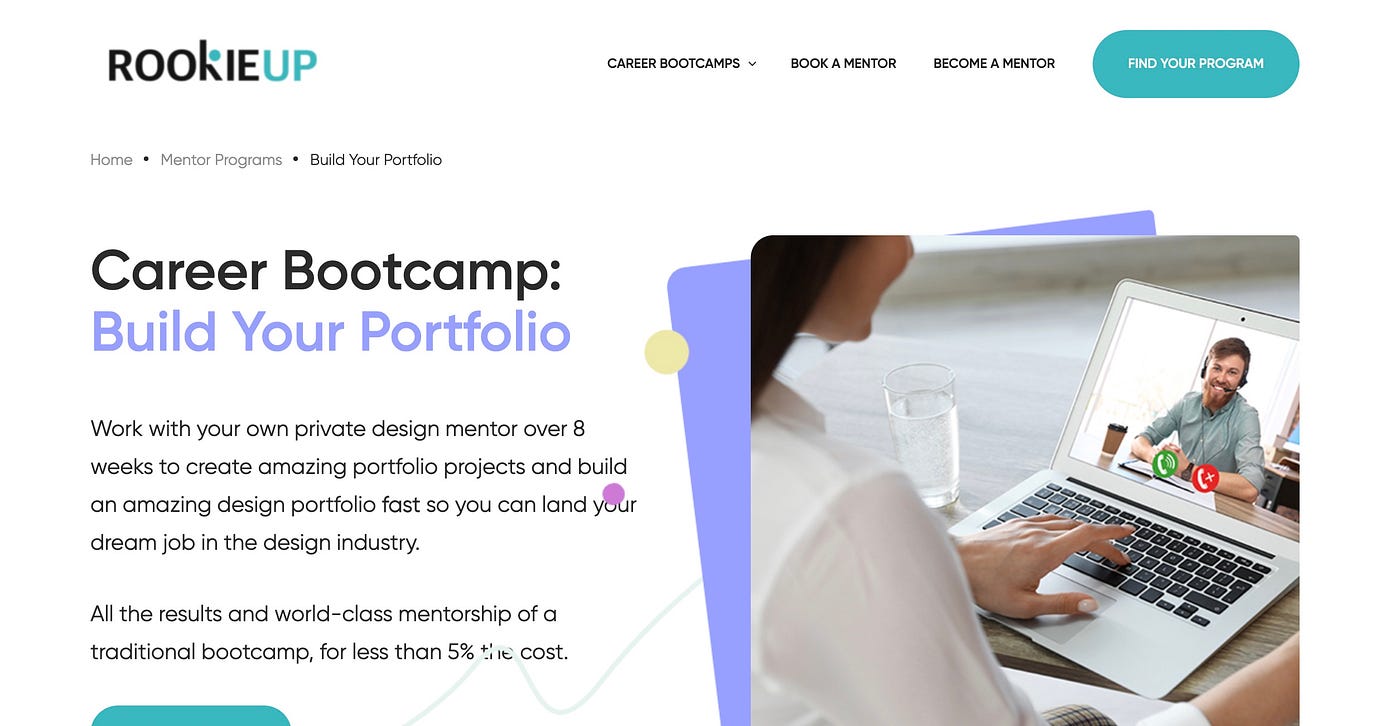When the pandemic hit, a lot of people hit “pause” on their careers because the fragility of life has finally made them realize that time is precious and now it’s the best time to start a new career they truly love. While many industries were hit hard by shutdowns, some industries boomed thanks to a sudden increase in demand and the fact that their services could be accessed remotely. Online education is one of them. Two years later, we are just now starting to see the unintended side effects of the boom in online education, specifically in online design bootcamps.
Too many “cookie cutter” candidates graduate from one-size-fits-all design bootcamps — all eagerly applying for the same jobs and many, are left frustrated and angry because, after months of applying, they realize that the thousands of dollars they invested in the bootcamps haven’t yielded the return they were hoping for.
Where did they go wrong? After all, many of their peers did land wonderful new jobs in a new field and now living a much more fulfilling life, according to the “student outcomes” pages of their bootcamps. Were they not as talented as their peers? Did they attend the wrong design bootcamps? Is it that the job market is simply too saturated? Or could it be something else?
Let’s back up for a little here.
Table of Contents
- Creative Education Was Never Meant to Be One-Size-Fits-All
- It’s Very Hard to Be Good At A New Craft in 3 Months
- The Problem of “Mentoring”
- The Lack of Branding and Visual Design Training is Detrimental to Job Applicant’s Success
- The Pitfalls of “Blue-Sky” Projects at Design Bootcamps
- UI and UX Design Bootcamps That Do Offer A Customized Learning Path
Creative Education Was Never Meant to Be One-Size-Fits-All
If we want to learn a musical instrument, the first step is to find a great teacher who will give us lessons, preferably one-on-one in private.
If we want to effectively treat a medical condition, we need to obtain prescription medication from a licensed medical provider. Over-the-counter medicine tends to only be effective for milder conditions and not for more complicated ones.
If we want to treat a skin condition, a custom formula prescribed by dermatologists or skin specialists is more ideal than products off the shelves.
When it comes to education, specifically creative education, there is no reason to expect otherwise.
In college, students can meet with advisors to figure out the best combination of courses they should take to get their degrees. Some universities now even have degree programs that allow students to decide on the directions they want to study.
Alternative education, which is the less expensive, more practical, and quicker route to learning job-ready skills, should be more flexible than traditional education, not less.
However, when we surveyed the landscape of the most popular “bootcamps” on the market, especially those for design, we didn’t see flexibility and customization. What we found is a standardized curriculum that is designed to be “one-size-fits-all”.
As a result, students finish their studies in record time (as little as a few weeks to a few months) but found themselves still without a job.
There are a few reasons why this “one-size-fits-all” and “fast-in-fast-out” approach doesn’t work.
It’s Very Hard to Be Good At A New Craft in 3 Months
First of all, it is unreasonable to expect anyone to become really good at a completely new craft that usually takes years of studying, practicing and creating to master.
While bootcamps did solve the problem of university degree programs being too expensive, taking too long, and too theory-focused in some instances, they fell short in instructional quality.
It is not hard to find out from a quick research on the content of instruction from various bootcamps the most teaching materials only scratch the surface of each topic.
What’s even more alarming is that in some design bootcamps, almost the entire teaching material is outsourced from existing articles online where students can technically obtain them for free.
The Problem of “Mentoring”
To make matters more complicated, many design bootcamps further outsource their education to a team of freelance “mentors” who are working professionals in the industry.
Undoubtedly, these mentors are highly-qualified in their profession and many of them are passionate about giving back while making some extra income. But how many of them have gone through formal instructional training? Very few, if any.
Knowing how to do something well is one thing — knowing how to teach someone else to do it is a completely different thing.
It is not surprising that some bootcamp students feel less satisfied with the instructional quality that they receive than their peers simply because the mentors they are working with aren’t the best in instruction.
The Lack of Branding and Visual Design Training is Detrimental to Job Applicant’s Success
When students get to the job application stage after taking a crash course in a new industry, they are hit with another challenge — portfolio, or the lack of excellence in it.
Unlike other fields, the creative industry demands proof of ability in the form of a portfolio — a collection of your best work. The resume is still important, but without a portfolio, it’s incredibly hard to convince employers that you know how to do the job.
The problem is that many students who came out of bootcamps couldn’t wow hiring managers with portfolio projects and sites that are clearly rushed and unpolished.
One of the most important aspects that are lacking is the absence of personal branding and visual design in these portfolios. Even if a candidate is going for a job such as UX design, which isn’t about the visual aspect of products, extra effort in the field of presentation is required to set the candidate apart from hundreds and thousands of others.
With a rushed and standardized curriculum that is sometimes worsened by uneven instructional quality, there is no doubt that portfolio quality gets slipped through the craft.
The Pitfalls of “Blue-Sky” Projects at Design Bootcamps
The last problem we want to bring to light is the abundance of “blue-sky” projects from many design bootcamp curricula.
“Blue-sky” projects are not necessarily fake projects — they can be quite real and address real, practical problems in the world.
However, if the project has not received feedback from real clients and is met with constraints in a business environment due to limited resources and timeline, it remains a “blue-sky” project that may not stand the test of constraints in the real world.
Some bootcamps have started to partner with real companies to give students extra opportunities to receive client feedback, which is an encouraging trend.
UI and UX Design Bootcamps That Do Offer A Customized Learning Path
So are there any “bootcamps” or rather, well-structured programs that cost much less than a college degree while affording students the same or even better-customized learning approach that creative education needs?
There are! Here are 4 that we recommend.
Path Unbound is an online design school that offers customized curriculum and course packages for each student. The School of Design program is an end-to-end learning experience that takes students from 0 to 100, including the portfolio building phase.

The program consists of 9 courses in color theory, typography, layout, UI design, design system, design accessibility, UI animation and interaction, branding and art direction.
The curriculum and study plan recommended for each student is different based on their existing background and diverse learning goals.
Students are able to build up to 9 portfolio projects and be paired with startups to receive real feedback for their design projects in the portfolio phase.
Unlike other bootcamps that rely on outsourced mentoring, Path Unbound has a team of expert instructors who have proven to not only excel in what they do professionally but also experienced in instructions.
One thing to note is, Path Unbound is focused on UI and visual design rather than UX design, although the basic principles of UX is touched upon throughout the school’s course offerings.
2. Path Unbound Portfolio School
Path Unbound also offers a stand-alone Portfolio School program for students who have learned design elsewhere but lacking portfolio development or career advice.
There are 2 tracks designed for students who are at different stages of portfolio building.
The Portfolio Express track provides 6-weeks of intensive branding, custom portfolio website building, visual design and portfolio project refinement training for students who already have at least 2–3 existing projects but are lacking in “wow factors”.
The Portfolio Kickstart track provides 12-weeks of portfolio project building as well as branding, visual design and custom website building training for students who have gained design knowledge but do not yet have portfolio-level projects.
The Portfolio School program is included as part of the School of Design program for students who are enrolled to receive the certificate.
3. RookieUp Build Your Portfolio Bootcamp
RookieUp Build Your Portfolio program is a highly-customizable design bootcamp that pairs a student with a mentor who provides feedback for students as they build portfolio projects and prepare for job search.

Based on the hours of video calls desired, students pay different tuitions for 4, 5 or 6 hours of total instructional time to review their portfolio projects.
RookieUp’s bootcamp also provides project prompts for students who do not already have ideas on what projects they want to work on for their portfolio.
SuperHi is an online design school that offers a wide variety of shorter courses in different disciplines. Students may choose the specific disciplines they are interested in, which essentially allows them to either fill in the blanks of what they are currently lacking or take one step at a time in exploring design as a career.
SuperHi offers some of the newest design courses in emerging areas such as Web3, Crypto, and AR design, which can be very interesting to established designers who want to expand their skillsets.
In comparison, Path Unbound also offers a similarly flexible approach for students who want to dip their toes into design without fully committing to a full learning program as each of the 9 courses in the School of Design program can also be taken separately.
For more dedicated students, SuperHi offers a membership program that allows students to access all of their courses, with limited career and mentor support compared to other programs.







